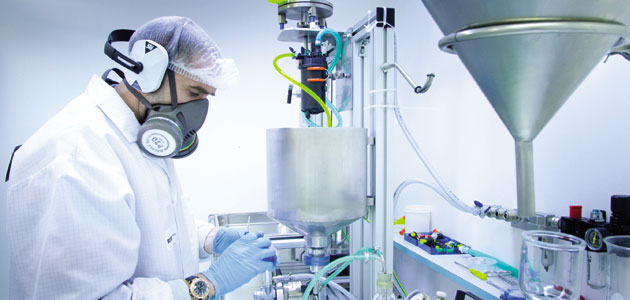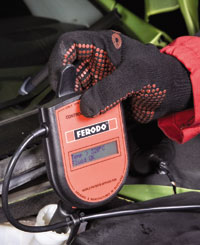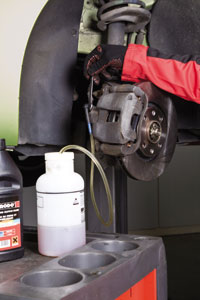
PMM turns to Federal-Mogul’s braking brand, Ferodo, to answer some common questions about brake fluid best practice.

Brake fluid is a mixture of synthetic organic chemicals which transmits hydraulic pressure from the brake pedal through hydraulic lines to the braking mechanism. To make this possible, brake fluid must be incompressible.
Braking generates considerable heat so, to resist these high temperatures without boiling, brake fluid is designed with a high boiling point. However, brake fluid is hygroscopic, which means it absorbs water, normally from the air through the flexible brake hoses or the reservoir breather. This moisture reduces the brake fluid’s boiling point.
Once this moisture absorption reaches a certain level the generated heat can cause the brake fluid to boil, creating gas bubbles. As gas is far more compressible than liquid, the driver will experience a lack of pressure on the brake pedal (a spongy pedal), resulting in a loss of brake power. This is known as ‘vapour lock’.
The brake fluid chosen to put into the hydraulic system is critical, with VMs recommending a specific type of fluid that should always be adhered to.

A GOOD FLUID SHOULD…
■ Be incompressible to give a solid pedal during braking
■ Have a high boiling point
■ Maintain performance during absorption of moisture
■ Have a viscosity that remains within closely defined parameters
■ Have the correct level of lubricity
■ Prevent corrosion
■ Have a controlled rubber swell to prevent shrinkage
SUGGESTED APPLICATIONS:
DOT 3: Front and rear drum brakes; hydraulic clutches
DOT 4: Front disc brakes, rear drum brakes; front and rear disc brakes; ABS
DOT 5.1: Heavy cars; high performances cars; ABS; extremely rigid climates
DOT 4-ESP: ESP, Electronic brake systems ESP
TESTING BRAKE FLUID
Although many vehicle and brake manufacturers give minimum recommendations, the right time to change the brake fluid shouldn’t be based on the vehicle’s mileage or age. The only real way to know is to test the brake fluid and the only approved way to test it is by boiling it. The most convenient place to test the fluid without disturbing the system is at the reservoir, this is also the place where the fluid is in direct contact with the air so is most vulnerable to water absorption.
Conductivity or “pentype” testers estimate the water content electronically. In theory, conductivity (and/or capacitance) increases with moisture content, but these testers can potentially fail new fluid and pass contaminated fluid. This is because the conductivity of brake fluid varies hugely from manufacturer-to-manufacturer, from batch-tobatch, and from grade-to-grade.
By using a purpose-designed brake fluid tester, like Ferodo’s own FFT100A, workshops can see, and show the customer, a clear digital reading of the actual boiling point in less than one minute. The test is fast and accurate so every vehicle that comes in for inspection or repair can be checked, delivering safety for the driver, and higher sales at the garage.

By using a purpose designed brake fluid tester workshops can see, and show the customer,
a clear digital reading of the actual boiling point in less than one minute.
HOW TO REPLACE BRAKE FLUID
Prior to bleeding the system, conduct a master cylinder leak pass test. This is done by attaching a pressure gauge to the closest caliper brake pipe.
The system must then be pressurized to 50 bar for 45 seconds, during which there should be no more than a 4 bar loss of pressure. More than a 4 bar pressure drop indicates a master cylinder leak pass, requiring further attention. A second check can also be carried out but at a lower pressure of 10 bar, still checking for loss of pressure and longer pedal travel to double-check for weaknesses in the system.
BLEEDING PROCESS – VEHICLES WITH FRONT AND REAR DISC BRAKES
All brake bleeding needs to be conducted in a set order, starting with the brake caliper furthest from the master cylinder. Some vehicles require a pressure bleed so it is always advisable to check the individual manufacturer’s recommendations first.
■ With all bleed nipples closed, fit a bleed pipe to the first caliper and loosen the nipple.
■ Using slow, full and firm strokes of the brake pedal continue until the brake fluid is visually (in the bleed pipe) clean, and clear of air bubbles.
■ With the pedal fully depressed tighten the bleed nipple, and remove the bleed pipe.
■ Continue to the opposite rear caliper and repeat the procedure.
■ After completing the rear calipers, make certain the front calipers are also properly functioning and free of air bubbles by bleeding the front calipers, starting also furthest from the master cylinder, and finishing closest to the master cylinder.
■ Finally ensure that an adequate pedal pressure is achieved.

All brake bleeding needs to be conducted in a set order,
starting with the brake caliper furthest from the master cylinder.
BLEEDING PROCESS – VEHICLES WITH DRUM BRAKES
The process is very similar to that of front and rear disc brakes, but prior to starting the bleeding process it is essential to ensure the correct manual adjustment (if present) is carried out to ensure the clearance is correct according to manufacturers’ specifications.
Over a quarter of UK motorists have defective brake fluid
Research conducted for Cosan Lubricants’ Comma brand, testing the quality of brake fluid at service garages across Europe, has found that 26.5% of UK motorists had defective brake fluid, with nearly one in 10 unintentionally risking their lives every time they drove. Overall across Europe, that figure rose to 41% of vehicles operating with sub-standard brake fluid.
While the poor quality of brake fluid in the nation’s cars was alarming, the study also revealed a worrying lack of understanding among motorists about how brake fluid functions – 75% of workshop customers either admitted that they don’t know how brake fluid works, or gave an inadequate account when questioned. More than a third (34%) had not changed their brake fluid for over two years.
The rest of Europe is not much better, with a total of 71% of motorists quizzed unable to explain how brake fluid works.









